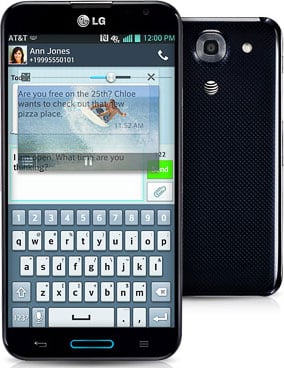LG's Optimus G Pro: High-End Hardware Better Utilized with Stand-Out Software Features
Today's high-end smartphones often feature quad-core processors, multiple gigabytes of RAM, and high-resolution displays. With high-end hardware specifications such as these, a smartphone has no problem chugging through daily tasks such as checking email, surfing the Internet, making calls, etc. While all of us use our phones for these tasks, our phones are capable of so much more. In fact, these hardware features enable a number of stand-out software features that help differentiate one high-end smartphone from another.
Recently, we took a hands-on look at the LG Optimus G ProTM. This smartphone has all of the hardware specifications you'd expect from one of today's high-end phones including a Snapdragon™ 1.7Ghz Quad-Core Processor SoC, 2GB of RAM, and 5.5-inch Full HD (1920 x 1080) IPS display. LG uses these high-end features of the phone to enable some really cool features that you won't find on other smartphones, including multitasking capabilities referred to as QSlide 2.0 and a unique camera mode called VR Panorama that is able to create a virtual 360 degree-like scene from a series of images.

QSlide 2.0 mode makes it possible to have multiple apps open at the same time, much as a person often does in Windows on a desktop or laptop computer. With QSlide 2.0, you can open a video file while also viewing a web page and writing a note in the Note Pad application. QSlide 2.0 compatible apps include Videos, Note Pad, Calendar, and Calculator. Each of these apps can be moved around the screen and resized while in QSlide 2.0 mode. You can also adjust the transparency of these apps in QSlide 2.0 mode.
You can adjust the transparency of QSlide 2.0 apps, as seen here.
While many phones today are capable of stitching together photos to form a panoramic image, most phones aren't able to stitch together images in both the horizontal and vertical directions to create a 360 degree-like scene. LG's VR Panorama mode can do just that. While taking pictures in this mode, the camera will display a small box that shows you where to point the camera next. You can capture up to a full 360 degrees if you want. Once you're finished capturing images, the phone will automatically stitch together the images into an all-encompassing picture. While viewing a VR Panorama image on the phone, the phone will pan around the entire image for you or you can slide your finger along the screen to pan in any direction.

Of course, there are some definite challenges associated with stitching pictures together, so you won't get perfect results every time you use VR Panorama, but during our tests we were able to capture some very impressive images outdoors using this mode. If you consider the image below for example, there are some definite challenges associated with stitching together images of moving objects, such as boats and jet skis. Even so, the VR Panorama feature found on the LG Optimus G Pro did an excellent job at creating a relatively smooth image without a lot of glaring stitch lines. Some of our test VR Panorama images were less impressive than this one due to obvious stitch lines, but it's still a very fun and interesting camera mode that wouldn't be possible without high-end hardware such as what is found in the Optimus G Pro.
This image was created using a series of images taken in VR Panorama mode on the LG Optimus G Pro.
QSlide 2.0 and VR Panorama are two great features of this phone, but without the LG Optimus G Pro's 5.5-inch Full HD (1920 x 1080) IPS display, they wouldn't be nearly as great as they are. Because the LG Optimus G Pro has a display that's significantly larger than most of today's smartphones, QSlide 2.0 makes sense. Although we love the idea of multitasking on any device we have, the truth is you need a large screen to actually take advantage of the ability to view more than one application at the same time.
When viewing the images created by VR Panorama mode and other images taken with the LG Optimus G Pro's 13 megapixel rear-facing camera, we also appreciated the sharp, crisp, and colorful display found on this phone that provides a really great look at the images. Thanks to its resolution and large size, the LG Optimus G Pro's 5.5-inch display is also great for watching movies on an airplane or playing games.
One of the ways manufacturers really set themselves apart with a smartphone is with the software features that come with the phone. LG has taken advantage of the high-end hardware found in the LG Optimus G Pro to implement some really cool software features that you won't find elsewhere on today's phones.
Thanks to LG Optimus G Pro and Technorati Media for sponsoring this article. All opinions expressed in this publication are the author's.





